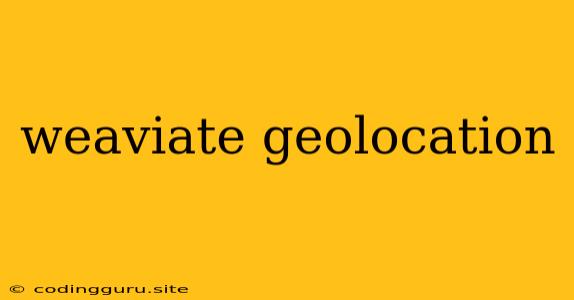Weaviate and Geolocation: Mastering Spatial Data with Ease
Weaviate, a powerful open-source vector search engine, has emerged as a game-changer for managing and querying vast amounts of data, particularly when it comes to geolocation data. Weaviate's ability to understand and search based on location empowers you to unlock powerful insights and build innovative applications.
What is Geolocation Data and Why is it Important?
Geolocation data refers to information about the geographic location of an object, person, or event. It encompasses latitude, longitude, altitude, and other spatial attributes. This type of data is increasingly crucial for various applications such as:
- Location-based services: Think ride-hailing apps, food delivery platforms, and navigation systems.
- Real estate: Finding properties based on proximity to specific locations, amenities, or landmarks.
- Retail: Understanding customer demographics and preferences based on their location.
- Environmental monitoring: Tracking pollution levels, deforestation, and other environmental changes.
Weaviate's Advantages for Geolocation Data
Weaviate shines in handling geolocation data thanks to its unique features:
- Vector Search: Weaviate allows you to search based on similarity rather than exact matches. This is ideal for finding locations close to a given point or within a specific radius.
- Multi-Modal Data: Weaviate can manage not only geolocation coordinates but also related information like descriptions, images, and text. This allows you to build richer and more context-aware applications.
- GraphQL API: Weaviate offers a flexible GraphQL interface for accessing and querying your data, making it easy to integrate with different applications and programming languages.
- Scalability and Performance: Weaviate is designed to handle large volumes of data and performs efficiently for location-based queries.
How to Use Weaviate for Geolocation
Here's a step-by-step guide on how to utilize Weaviate's capabilities for geolocation data:
- Create a Weaviate Instance: Start by setting up a Weaviate instance using Docker, Kubernetes, or the official installer.
- Define a Schema: Define a schema to describe your data, including a dedicated
geofield for your geolocation coordinates. - Import Data: Load your data into Weaviate using the provided tools or APIs, ensuring you populate the
geofield with accurate coordinates. - Query for Locations: Utilize Weaviate's GraphQL API to query for locations based on various criteria:
- Near: Find locations within a specific distance of a given point.
- Within: Identify locations within a defined bounding box or polygon.
- Contains: Discover locations that contain a specific point.
- Explore Relationships: Leverage Weaviate's ability to connect geolocation data with other information, enabling you to analyze location-based trends and patterns.
Example Use Cases
Let's explore a few practical examples of how Weaviate can be used with geolocation data:
- Restaurant Recommendations: Build a service that suggests restaurants near a user's current location, considering factors like cuisine, ratings, and price range.
- Emergency Response: Track the location of emergency vehicles in real-time and dispatch them to incidents based on proximity and available resources.
- Urban Planning: Analyze the distribution of population density, infrastructure, and green spaces to support better urban planning decisions.
Conclusion
Weaviate's ability to efficiently manage and search geolocation data opens a world of possibilities. Whether you are developing location-based services, analyzing spatial data, or building innovative applications, Weaviate empowers you to leverage the power of location with ease. Its intuitive interface, advanced features, and scalable architecture make it an ideal choice for tackling complex geolocation challenges in today's data-driven world.
